Description
ABSTRACT
The effect of substituting granulated sugar with date palm fruit pulp meal DPFPM in cake production was evaluated. Date palm fruit pulp was oven dried 46C, 8 h and milled. Granulated sugar was substituted at 0, 25, 50, 75 and 100 with DPFPM in cake recipe and cake produced using straight dough bulk fermentation method. Proofing ability of the dough, oven spring, cake loaf weight, volume and specific volume were evaluated. Proximate composition, incidence of mold growth on cake loaves and sensory properties of the loaves were also determined. On dry weight basis, crude fat, crude fiber, crude protein and ash contents significantly p lt; 0.05 increased from 6.25 to 7.72, 1.52 to 4.45, 16.85 to 21.26, and 2.26 to 3.84, respectively, whereas carbohydrate decreased from 73.12 to 62.73 with increasing substitution of sugar with DPFPM. The decrease in proofing ability of the dough 2.20 to 2.08 was insignificant p gt; 0.05 while the decreases in oven spring 2.30 to 1.87 cm, loaf volume 848.3 to 762.3 cm3 and specific volume 3.15 to 2.64 cm3/g were significant p lt; 0.05. Loaf weight increased p lt; 0.05 from 265.5 to 288.8 g. visually observable colonies of mold on cake loaves during storage initially decreased but later increased with increasing DPFPM. Substituting sugar with DPFPM had no adverse overall effect on the acceptability of cake loaves; it however increased the nutritional value but decreased the physical quality of the cake loaves.
CHAPTER ONE
1.0.INTRODUCTION
The term cake has a long history. The word itself is of Viking origin, from the Old Norse word kaka.
Although clear examples of the difference between cake and Cake are easy to find, the precise classification has always been elusive. For example, banana Cake may be properly considered either a quick Cake or a cake.
Cake is a form of sweet dessert that is typically baked. In its oldest forms, cakes were modifications of Cakes but now cover a wide range of preparations that can be simple or elaborate and share features with other desserts such as pastries, meringues, custards and pies.
Typical cake ingredients are flour, sugar, eggs, butter or oil, a liquid, and leavening agents, such as baking soda and/or baking powder. Common additional ingredients and flavourings include dried, candied or fresh fruit, nuts, cocoa, and extracts such as vanilla, with numerous substitutions for the primary ingredients. Cakes can also be filled with fruit preserves or dessert sauces like pastry cream, iced with buttercream or other icings, and decorated with marzipan, piped borders, or candied fruit.
Cake is often served as a celebratory dish on ceremonial occasions, for example weddings, anniversaries, and birthdays. There are countless cake recipes; some are Cakelike, some rich and elaborate, and many are centuries old. Cake making is no longer a complicated procedure; while at one time considerable labour went into cake making particularly the whisking of egg foams, baking equipment and directions have been simplified so that even the most amateur cook may bake a cake.
1.1.BACKGROUND OF THE STUDY:
Cake is one of the commonest staple food eaten World over. It is composed of dough from wheat, yeast, water and other ingredients, which has been fermented and subsequently baked. When the dough is made, the yeast starts to work on the fermentable sugars, transforming them into alcohol and carbon dioxide, thus increasing the dough volume. Sugar, though used as ingredient in Cake, is not considered essential or indispensable in Cake making. This is because flour contains a small amount of natural sugar and some starch is converted to sugar during fermentation process. The natural sugar content of the flour, however, is very limited in amount and for most forms of Cake, sugary agent must be added to meet the usual yeast requirements throughout the fermentation process and also supply the necessary sweetness and other functions performed by sugar in Cake baking. Wihlfaht, 2007.
Apart from providing substrate to yeast for CO2 production and imparting sweetness to baked goods, other functions of sugar include the production of golden brown colour of the crust, improvement of texture of the crumb, retention of moisture in the crumb and adding to the nutritional value of Cake.
Many sugar substitutes are available for use in baking especially in a situation where lowcalorie alternative may affect positively a medical condition such as diabetes where sugar consumption is severely limited. Some natural alternatives to white sugar for bakery products namely raw honey, maple syrup, molasses, corn syrup, stervia, xylitol, agava nectar, brown rice syrup, evaporated cane juice, black strap molasses, date sugar and organic sugar have been listed by Anon 2010, and Khan 2010. Khan 2010 reported that one cup of date sugar is equivalent to one cup of granulated or brown sugar. NHB and AIB 1990 and Ebiringa and Echebiri 2004 used honey as sugar substitute in Cake production, Akubor and Yusuf 2007 used date palm syrup in cake production.
Date palm Phoenix dactylifera L. fruit, locally called debino in Hausa language, is from the family of Arecaceae Aldaihan and Bhat, 2012. It is cultivated for its edible sweet fruit. The fruit is a drupe in which an outer fleshy part exocarp and mesocarp referred to as pulp Besbes et al., 2010 and pericarp Duke 1981 surround a shell the pit or stone of hard endocarp with a seed inside. The fruit is available in different forms namely whole pitted and unpitted, dehydrated pieces, diced, extruded date pieces and macerated fruit Berreveld, 1993; Glasner et al., 2002. Barreveld 1993 reported that a date palm fruit of 20 moisture content provides 3,000 kcal/ kg of date flesh.
Ahmed et al. 1995 and Vandercook et al. 1980 documented that date fruits are high energy food sources with 72 to 80 sugar content at maturity. At khalal stage, nearly all 80 to 85 of the sugar is sucrose. As ripening progresses, the sucrose is hydrolysed into reduced sugars such as glucose and fructose. AlShahib and Marshal 2003 stated that the fruit of date palm contains a high percentage of carbohydrate total sugar, 44 to 88, fat 0.2 to 0.5, 13 salts and minerals, protein 2.3 to 5.6, vitamins and a high percentage of dietary fibre 6.4 to 11.5. Ahmed et al. 1995 and Vandercook et al. 1980 reported that date fruit are good sources of iron and potassium, a fair source of calcium, chlorine, copper, magnesium and sulphur, and a minor source of 16 amino acids and vitamins A, B1 and B2.
Many products useful to humans are produced from date palm. The primary product is the fruit which is eaten fresh, dried or various processed forms Glasner et al., 2002; Kader 1992. Dry or soft dates are eaten out of hand or may be seeded and stuffed, or chopped and used in great variety of ways on cereal pudding, Cake,
cakes, cookies, ice cream or candy bars Barreveld 1993; Glasner et al., 2002; and can be made into juice, vinegar, wine, beer, sugar, syrup, honey, pickle, paste, dip and food flavour Barreveld 1993; Glasner et al., 2002.
Date fruit pulp has been used more as a sugar source than as a fruit Barreveld 1993. Date sugar is manufactured by processing dried dates into powder form and is great for sprinkling on breakfast cereal and baked goods Khan 2010. In this study, date pulp meal was used as replacement for granulated sugar in Cake production with the aim of evaluating the physicochemical, organoleptic and storage properties of the Cake.
1.2.STATEMENT OF PROBLEM:
The following forms the statement of problem of this study;
1.Seeking out an alternative to sugar used in the production of cake as it has been discovered that excessive sugar in the body have several demerits.
2.The scarcity of pure sugar in some localities.
3.The need to employ a natural sugar source to the production of cake.
4.The high need to bring about a new taste and quality improvement in the production of cake.
1.3.OBJECTIVES OF THE STUDY:
The objectives of this study are as follows;
1.To produce a cake with a sugar alternative.
2.To show that there is another ingredient that can be used to replace sugar in the production of cake.
3.To boost the nutritional level of cake through the introduction of an alternative for sugar called palm pulp.
1.4.AIM OF THE STUDY:
The aim of this project work is to successfully produce a cake using an alternative for sugar. This is aimed at so that people with sugar related medical issues can as well consume cakes. To this end, a lot of alternative was reviewed and date palm syrup was chosen as the best alternative due to its inherent natural sweetness.
1.5.SIGNIFICANCE OF THE STUDY:
The significance of this project work is to produce a cake using an alternative for sugar. This is aimed at so that people with sugar related medical issues can as well consume cakes. To this end, a lot of alternative was reviewed and date palm syrup was chosen as the best alternative due to its inherent natural sweetness.
1.6.LIMITATION OF THE STUDY:
Although the aim of the project work was achieved, the successful research of the work was challenged. The choice of choosing the best alternative for sugar was challenged. This is because the research did not have enough resources to analyse all the options so as to choose the best alternative.
1.7.SCOPE OF THE STUDY:
The research work sited here only covers the use of sugar alternative in the production of cake in which case date palm syrup was chosen by the researcher to be a case study. This therefore means that the sugar alternative used in the project work as at the time it was written was date palm syrup.

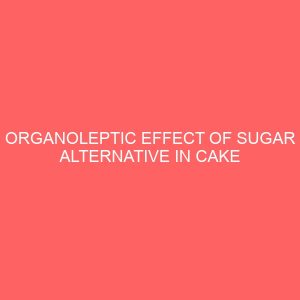
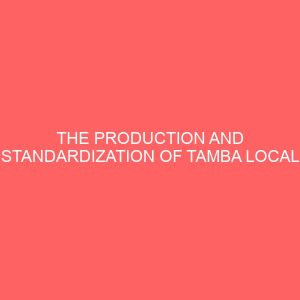


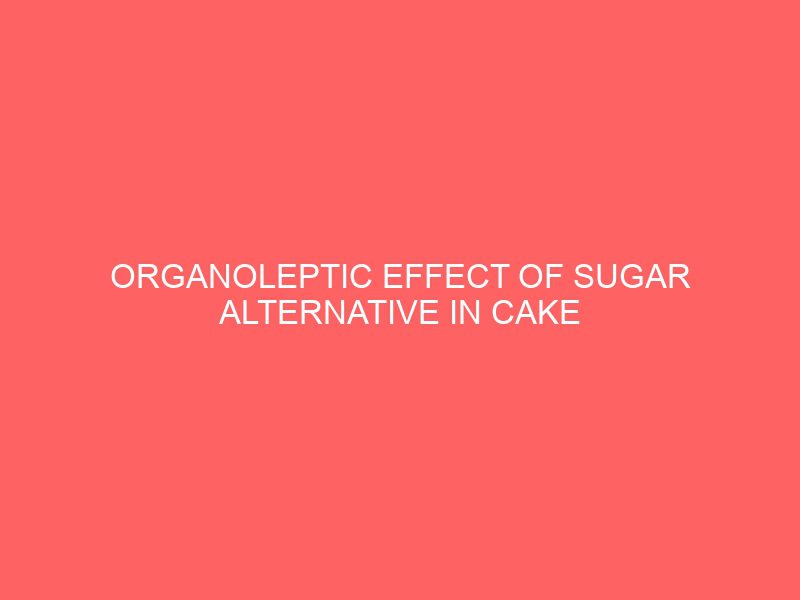
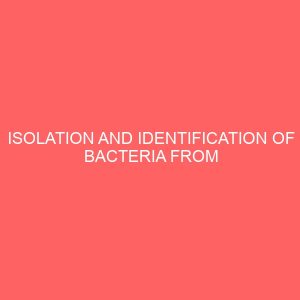
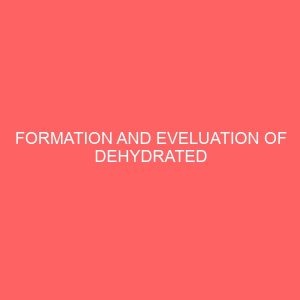
Reviews
There are no reviews yet.